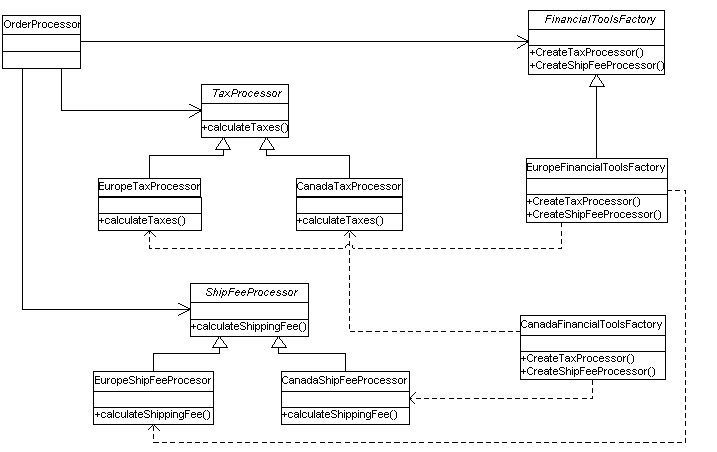Abstract Factory Pattern, UML diagram, Java Example
- Definition
- Class Diagram
- Participants
- Example: Financial Tools Factory
- Example: Class Diagram
- Example: Java sample code
- Benefits
- Usage
Definition
Provides an interface for creating families of related or dependent objects without specifying their concrete classes.
Class Diagram

Participants
-
Abstract Factory (FinancialToolsFactory)
- declares an interface for operations that create abstract products objects
-
Concrete Factory (EuropeFinancialToolsFactory, CanadaFinancialToolsFactory)
- implements the operations to create concrete product objects
-
Abstract Product (TaxProcessor, ShipFeeProcessor)
- declares an interface for a type of product object
-
Concrete Product (EuropeTaxProcessor, CanadaTaxProcessor, EuropeShipFeeProcessor, CanadaShipFeeProcessor)
- defines a product object to be created by the corresponding concrete factory implements the AbstractProduct interface
-
Client (OrderProcessor)
- uses interfaces declared by AbstractFactory and AbstractProduct classes
Example: Financial Tools Factory
Example: Class Diagram

Example: Java sample code
// Factories
package com.apwebco.patterns.gof.abstractfactory;
public abstract class FinancialToolsFactory {
public abstract TaxProcessor createTaxProcessor();
public abstract ShipFeeProcessor createShipFeeProcessor();
}
public class CanadaFinancialToolsFactory extends FinancialToolsFactory {
public TaxProcessor createTaxProcessor() {
return new CanadaTaxProcessor();
}
public ShipFeeProcessor createShipFeeProcessor() {
return new CanadaShipFeeProcessor();
}
}
public class EuropeFinancialToolsFactory extends FinancialToolsFactory {
public TaxProcessor createTaxProcessor() {
return new EuropeTaxProcessor();
}
public ShipFeeProcessor createShipFeeProcessor() {
return new EuropeShipFeeProcessor();
}
}
// Products
public abstract class ShipFeeProcessor {
abstract void calculateShipFee(Order order);
}
public abstract class TaxProcessor {
abstract void calculateTaxes(Order order);
}
public class EuropeShipFeeProcessor extends ShipFeeProcessor {
public void calculateShipFee(Order order) {
// insert here Europe specific ship fee calculation
}
}
public class CanadaShipFeeProcessor extends ShipFeeProcessor {
public void calculateShipFee(Order order) {
// insert here Canada specific ship fee calculation
}
}
public class EuropeTaxProcessor extends TaxProcessor {
public void calculateTaxes(Order order) {
// insert here Europe specific taxt calculation
}
}
public class CanadaTaxProcessor extends TaxProcessor {
public void calculateTaxes(Order order) {
// insert here Canada specific taxt calculation
}
}
// Client
public class OrderProcessor {
private TaxProcessor taxProcessor;
private ShipFeeProcessor shipFeeProcessor;
public OrderProcessor(FinancialToolsFactory factory) {
taxProcessor = factory.createTaxProcessor();
shipFeeProcessor = factory.createShipFeeProcessor();
}
public void processOrder (Order order) {
// ....
taxProcessor.calculateTaxes(order);
shipFeeProcessor.calculateShipFee(order);
// ....
}
}
// Integration with the overall application
public class Application {
public static void main(String[] args) {
// .....
String countryCode = "EU";
Customer customer = new Customer();
Order order = new Order();
OrderProcessor orderProcessor = null;
FinancialToolsFactory factory = null;
if (countryCode == "EU") {
factory = new EuropeFinancialToolsFactory();
} else if (countryCode == "CA") {
factory = new CanadaFinancialToolsFactory();
}
orderProcessor = new OrderProcessor(factory);
orderProcessor.processOrder(order);
}
}
Benefits
- Isolates concrete classes
- Allows to change product family easily
- Promotes consistency among products
Usage
- When the system needs to be independent of how its products are created composed and represented.
- When the system needs to be configured with one of multiple families of products.
- When a family of products need to be used together and this constraint needs to be enforced.
- When you need to provide a library of products, expose their interfaces not the implementation.




